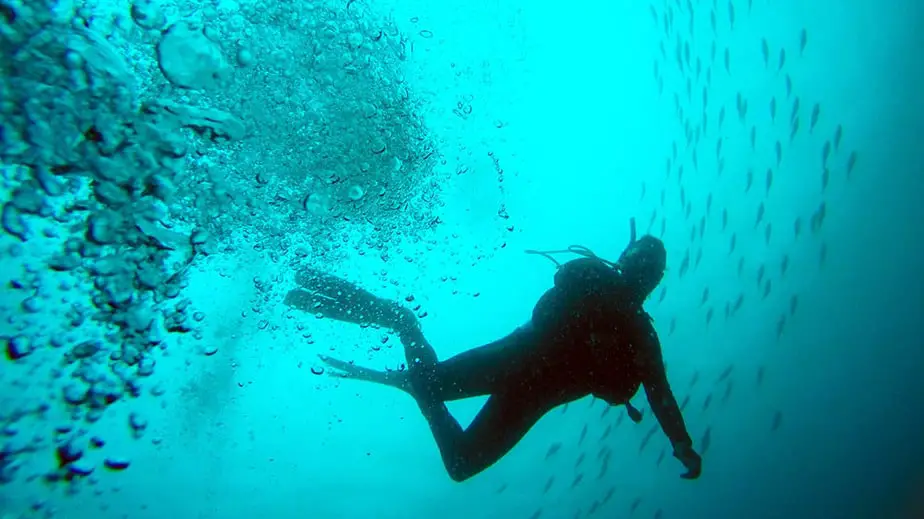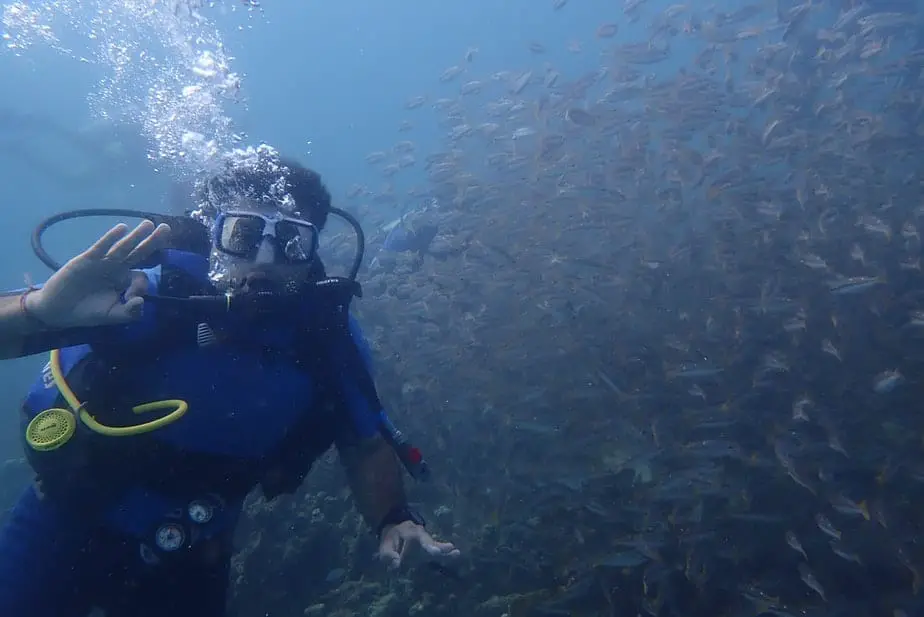A common question students have during the Open Water course is what the difference is between nitrogen narcosis and decompression sickness (the bends). Both of these conditions are caused by an excess amount of nitrogen gas. However, gas narcosis and the bends have very different symptoms and they both require different treatments.
In this article, we’ll discuss what nitrogen narcosis and decompression sickness are, and compare the two conditions to help beginners differentiate between the two.
What is nitrogen narcosis?
Gas narcosis is an impaired state of awareness caused by breathing highly pressurized nitrogen gas. The deeper a diver goes, the more potent the narcosis will be due to the greater partial pressure of gas being inhaled.
Some divers have compared the feeling of nitrogen narcosis to being pleasantly intoxicated, whereas others find this impaired state to be terrifying. The high concentration of nitrogen gas can also act as a mild anesthetic. The gas that causes the narcosis remains partly dissolved in one’s tissues and does not form bubbles.
Effects of nitrogen narcosis
Nitrogen narcosis is one factor that will limit how deep you can dive. How limiting it is depends on various factors, such as one’s age, sex, and physical condition. Since gas narcosis directly affects your perception, it is difficult for you to objectively recognize how badly it affects you.
Since narcosis causes intoxication similar to the effects of alcohol or marijuana, many divers report they feel a sense of relief from anxiety. They feel tranquil and at one with the environment, or some such dreamlike revelation.
The impaired state that being narc’d causes is not itself dangerous. However, the danger lies with the impaired judgment, decreased coordination, difficulty with multi-tasking, and loss of focus and decision-making ability.
Divers may make poor decisions or completely ignore safety guidelines while they are in this intoxicated state. Despite causing one to reach a state of euphoria, nitrogen narcosis can in fact be deadly if it causes you to make serious mistakes you otherwise wouldn’t. (E.g. Ignoring decompression stops, exceeding the bottom time or diving deeper than usual, etc).
Treating nitrogen narcosis
Thankfully, nitrogen narcosis is completely and quickly reversible in just a few minutes by ascending to a shallow depth. It has no long-term effects and the nitrogen gas causing the narcosis does not form bubbles.
The severity of the nitrogen narcosis depends on the depth the diver stays at. This relation between the depth to narcosis is informally referred to as “Martini’s Law”, which states that the level of intoxication one feels is equivalent to drinking one Martini for every 10 meter (33 feet) below the 20 meter (66 feet) mark.
It is for this reason that it is not recommended for one to drink alcohol before diving. The impairment caused by the alcohol in your system will worsen when the body experiences nitrogen narcosis. In other words, the effects compound, and one will feel inebriated much faster and suffer the same effects as being drunk.
Just like with nitrogen narcosis, the treatment for alcohol in your system is simply time. Unfortunately, where nitrogen narcosis takes just a few minutes to recover from, alcohol in your system gets metabolized at a rate of approximately one standard drink per hour for men.
What is decompression sickness?
Decompression sickness is a physical condition a diver can experience when they ascend to the surface too quickly. What is happening within the body is that the excess nitrogen in the body’s tissue and bloodstream rapidly releases the nitrogen gas in the form of bubbles. These bubbles, though small, can restrict blood flow to various parts of the body and can seriously damage tissues.
Think of a bottled carbonated drink at rest. At first glance, it seems like a regular drink. Give it a shake, however, and you’ll notice bubbles fizzing at the top. This is essentially what is happening inside your body if you go up too quickly without performing any decompression stops or a safety stop. The gas is coming out of solution and forming bubbles.
Effects of decompression sickness
On every dive, a diver’s body will absorb nitrogen as well as other inert gases from breathing the compressed air in their tank. Like with nitrogen narcosis, the effects are stronger the deeper and longer one dives.
For instance, at shallow recreational depths of only 10 meters (33 feet), a diver can dive for over three hours without needing to perform a decompression stop. Conversely, at a depth of 42 meters (140 feet), it takes approximately 8 minutes for a diver to exceed their no-decompression limit (NDL) and they will be forced to perform decompression stops during the ascent.
What is decompression? During the ascent, as the diver goes from a higher pressure environment to a lower pressure one, the gases in their system expands. Typically, gas travels through the diver’s bloodstream until it reaches the lungs and is exhaled. When there is an excess amount of nitrogen, the body cannot properly expel it, and the gas remains trapped in the body and forming bubbles.
The bubbles “form most commonly in the blood and tissues of the spine, nerves, joints, and skin.” The side-effects include confusion, impaired thinking, but can also lead to extreme pain, loss of feeling in certain parts of the body, hallucinations, vertigo, paralysis, and even death. A bubble can even restrict blood flow and cause permanent damage to organs and tissues.
Divers will generally experience symptoms of decompression sickness a few hours or even a day after a dive where they did not properly decompress.
Treating decompression sickness
Treating decompression sickness is a lot more complicated than nitrogen narcosis which basically takes care of itself.
The best way to deal with decompression sickness is to take steps to prevent it from occurring in the first place. Preventing decompression sickness is a simple matter of giving your body time to off-gas before surfacing.
To this end, divers should not ascend any faster than 9 meters (30 feet) per minute. If it is a decompression dive, one will need to perform numerous decompression stops which can be calculated by a dive table or dive computer.
At a distance of around 3-6 meters (10-20 feet) below the surface, divers should perform a safety stop lasting 3-5 minutes. A safety stop is highly recommended for all dives, even shallow water dives, because the body can absorb excess nitrogen at any depth.
Sometimes, even after performing the above decompression steps, a diver can still experience the effects of decompression sickness. This could be due to their physiology making them more susceptible to it. Or it can be because they traveled to a high altitude, most commonly by flying on an aircraft, shortly after diving.
Whatever the case, if you or someone you know is suffering from decompression sickness, the treatment for this is to supply them with 100% oxygen and transport them to a hospital with a hyperbaric chamber. Avoid air travel during transportation.
A hyperbaric chamber is a pressurized chamber that mimics the pressure experienced at depth. The hyperbaric chamber will be pressurized to match the depth the diver was diving at, and will slowly decrease the pressure over time, until eventually the atmospheric pressure is back to normal. This gives the body time to safely dissolve the nitrogen.
Time is of the essence. As mentioned, the bubbles can travel to all sorts of places in the body and cause irreversible damage. Furthermore, one should have ample surface intervals to allow the residual nitrogen in their system to dissolve before going on their next dive. Going again too soon puts one at increased risk of decompression sickness.
Nitrogen narcosis vs. the bends

Now that you know a little bit about both nitrogen narcosis and decompression sickness, let’s compare them head on and see where they are similar and where they differ.
Similarities
- Both nitrogen narcosis and decompression sickness (the bends) are brought on by excess nitrogen gas in the body.
- Both are affected by depth and time. The deeper a diver dives and the longer they stay at that depth, the greater the risk of both.
- Decompression sickness and nitrogen narcosis can be fatal! In the case of nitrogen narcosis, it’s not the condition itself that is fatal, but the impaired judgment that can result in a fatal situation.
Differences
- Nitrogen narcosis is brought on by diving deeper and its effects wear off as one ascends. Decompression sickness is brought on by ascending too quickly from a deep depth without stopping.
- Though both conditions are brought on by nitrogen gas, nitrogen narcosis is caused by dissolved nitrogen. On the other hand, decompression sickness is caused when the dissolved nitrogen comes out of the solution as bubbles and travels where it shouldn’t.
- Nitrogen narcosis affects one’s brain. The bends can affect any part of the body, including the brain.
- To prevent the bends, one must perform a slow, controlled ascent and do a deco stop when necessary. The ascent rate has no effect on nitrogen narcosis, however you should still ascend slowly to prevent the bends.
- Depending on the individual, nitrogen narcosis can happen around the 20-30 meter (66-100 feet) mark, and is especially more potent below 30 meters (100 feet). The bends occur at the end of a dive, perhaps several hours later, when the body is saturated with nitrogen.
- Decompression sickness can occur even on the surface by going from sea level to a higher elevation. Nitrogen narcosis will cease by the surface and does not cause any permanent effects.
- The symptoms of nitrogen narcosis are not as severe as decompression sickness. Both can cause confusion and impaired judgment, but the bends can also cause pain, hallucinations, vertigo, paralysis, tingling sensation, reduced blood flow to organs, and death.
As you can see, even though both nitrogen narcosis and decompression sickness are caused by nitrogen gas, they have very little similarities otherwise. Once the details of both conditions are understood, it becomes clear that these conditions are very different but great care should be taken to avoid them nonetheless.

